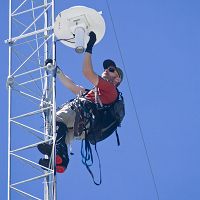Meadows, 2013
Using large-scale, shallow soil water measurements to estimate deeper soil water storage in a mixed-conifer forest of the Southern Sierra Nevada
Meadows, M. (2013)
GSA 109th Cordilleran Section Meeting
-
Sierra, STAFF
Abstract
Soil moisture was measured in the southern Sierra Nevada using cosmic-ray, time domain reflectometry (TDR), dielectric, neutron probe, and gravimetric or volumetric sampling techniques. These techniques are compared to: 1) develop a better understanding of shallow (0-50 cm) soil moisture from plot and hectare scales, and 2) determine the feasibility of estimating deep soil moisture using large-scale, shallow soil moisture measurements. Multiple embedded sensors (TDR and dielectric) were deployed across varying soil depths, aspects, and canopy covers to capture spatial and temporal variations of soil volumetric water content within the spatial range of a COsmic-ray Soil Moisture Observing Systems (COSMOS) and throughout a 4 km2 headwater catchment. Through a one-year period, June 2011-June 2012, area-average volumetric water contents observed by COSMOS were compared to real-time, in situ observations of soil moisture using TDR and dielectric sensors, and with measurements of soil moisture taken periodically during surveys within the COSMOS footprint. Surveys of soil moisture in the upper 40 cm of soil were made along transects around the COSMOS with handheld TDR and gravimetric sampling techniques. A neutron probe was also used to measure soil moisture at 14 locations within the COSMSO footprint.
Results show that the COSMOS and the embedded sensor networks effectively observed trends of snow disappearance and soil drainage throughout the summer and fall, and track diurnal and seasonal trends in the near-surface soil profile. The addition of snow during the winter of water-year 2012 complicates the COSMOS signal. The COSMOS measurement was limited to approximately 6 cm of water and had an effective measurement depth between 15 and 30 cm. Throughout the basin 55% of the variability in the 90 cm water content observations on hillslopes was explained by the COSMOS observations during no-snow conditions. These data suggest that the COSMOS observations could be used for a watershed-scale soil moisture index for depths up to 90cm.
This research is part of the NSF-supported Southern Sierra Critical Zone Observatory, which is co-located within the U.S. Forest Service, Kings River Experimental Watershed.
Citation
Meadows, M. (2013): Using large-scale, shallow soil water measurements to estimate deeper soil water storage in a mixed-conifer forest of the Southern Sierra Nevada. GSA 109th Cordilleran Section Meeting.
 This Paper/Book acknowledges NSF CZO grant support.
This Paper/Book acknowledges NSF CZO grant support.
Explore Further

